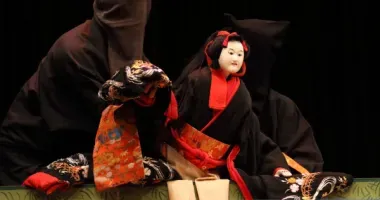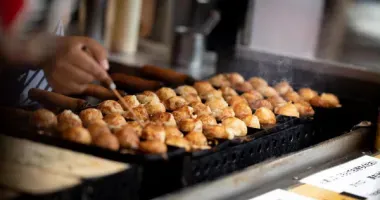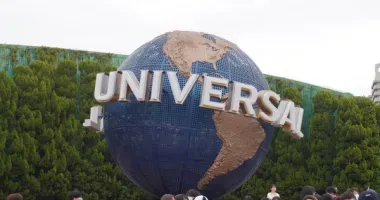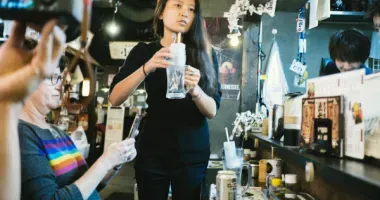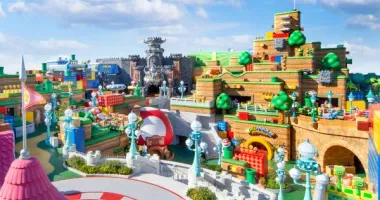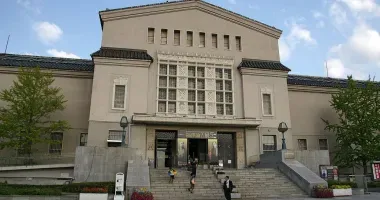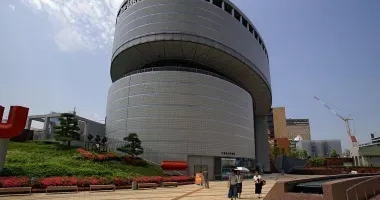Osaka Museum Guide Listing
Osaka museum guide: see a list of museums and art galleries in Osaka divided by region including Osaka Castle area, Minami and Tennoji.
- Osaka Castle Area Museums
- Nakanoshima Area Museums
- Tempozan - Osaka Bay Area Museums
- Minami Area Museums
- Tennoji Area Museums
- Other Museums in Osaka
- Japan Museums
Museums & Galleries in Osaka Listing 博物館, 大阪
Osaka as befits a city of its history, size and importance has a number of fine museums and art galleries and a popular aquarium.
See below for a list of museums in Osaka.
 Peace Osaka
Peace Osaka The Osaka Museum of History is inside a modernist tower
The Osaka Museum of History is inside a modernist tower
Osaka Castle Area Museums
The area around Osaka Castle is a good place to start for museums in Osaka.
Osaka Museum of History is housed in a modernistic multi-storey tower, adjacent to the Osaka NHK Broadcast Center. There are great views of Osaka Castle and the city below from the top floors of the museum, worth the price of admission alone.
Osaka Museum of History opened in 2001 and is dedicated to the history of Osaka from ancient to modern times. The Osaka Museum of History is a short walk from Exit 9 of Tanimachi 4-Chome Station on the Tanimachi and Chuo lines of the Osaka subway and close to the Remains of Naniwa-no-miya Palace. Hours: 9.30am-5pm (Fridays 9.30am-8pm), closed Tuesday.
Admission: Adults 600 yen; students 400 yen. Tel: 06 6946 5728.
Peace Osaka (aka Osaka International Peace Center; ピースおおさか) has exhibits detailing the effects of World War II on the city - including a reproduction of a 1-ton US bomb.
Peace Osaka has exhibits, photographs and materials relating to the war as it affected the citizens of Osaka with some exhibits dealing with the conflict in China and Okinawa. Access to Peace Osaka is from Morinomiya Station on the JR Osaka Loop Line (Kanjosen) or Morinomiya subway station. Closed Monday. Admission: Adults 250 yen. Tel: 06 6947 7208.
North west of Osaka-jo Koen across the Okawa River is the Mint Museum of the Osaka Mint Bureau (Zoheikyoku). The Osaka Mint opened in 1871 and has a museum with a large collection of Japanese coins and medals. It is also possible to see something of present-day production methods on a tour of the mint with an advance booking: Tel: 06 6351 6150.
Both the tour and the museum are open Monday through Friday and admission is free. The grounds of the Mint along the river are opened to the public for a short period in spring so visitors can enjoy over 100 varieties of cherry trees in full bloom. Access to the Osaka Mint is from Tenmabashi station on the Tanimachi subway line or Keihan line, or from Minamimorimachi station on the Tanimachi or Sakaisuji subway lines.
Google Map
 The Sempukan - designed as a guest house for the Osaka Mint
The Sempukan - designed as a guest house for the Osaka Mint
 Original Front Entrance of the Former National Mint Foundry
Original Front Entrance of the Former National Mint Foundry
Across the river from the Mint Museum is the Sempukan (泉布観), the oldest western-style building in Osaka. The Sempukan dates from 1870 and was designed in colonial-style by the British architect Tom Waters (1842-1898) as a guest house for the Japan Mint, which was also his design. The building had western style toilets complete with running water and the Emperor Meiji stayed here on a visit to the city in 1872. The Sempukan is undergoing renovation and is presently closed to the public. Waters went on to design the famous Bricktown in the Ginza district of Tokyo, among various commissions in Japan. Behind the Sempukan is the Original Front Entrance of the Former National Mint Foundry, which is used as a backdrop for wedding photos by the nearby Kyusakuranomiya Kokaido wedding chapel.
Nakanoshima Area Museums

The Nakanoshima area, located on an island in the northern part of Osaka, is the financial and administrative hub of the city. The Osaka Science Museum opened in 1989 in Nakanoshima and has four floors covering electricity and electronic appliances, science and the family, science in everyday life and space and space exploration. The museum presents a number of "Science Shows" running throughout the day. The basement floor houses the museum's planetarium, which is one of the largest in Japan.
The Osaka Science Museum is a short walk west from Exit #3 of Higobashi Station on the Yotsubashi Line of the Osaka subway and even closer to Watanabehashi Station on the Keihan Nakanoshima Line. The museum is a longer walk from Fukushima Station on the Hanshin and Osaka Loop lines. Museum: Admission 400 yen for adults; 9:30 am - 5 pm (last entry 4:30 pm), closed Monday; Planetarium: Admission 600 yen for adults; 9:30 am - 5 pm (last entry 4:30 pm), closed Monday except when Monday is a national holiday, in which case open on Monday and closed the next day. Tel: 06 6444 5656
Google map

Osaka National Museum of Art was originally the Expo Museum of Fine Arts in Expo '70 Commemorative Park in Suita and opened as a museum in 1977 before moving to Nakanoshima in 2004. The Osaka National Museum of Art has a collection of over 6,000 works of 20th and 21st century artists both Japanese and foreign such as Yayoi Kusama, Yoshitomo Nara, Pablo Picasso, Gerhard Richter, Marcel Duchamp, Giorgio Morandi and Andy Warhol. In addition Osaka National Museum of Art has a large collection of contemporary photography and over 300 sculptures. Tel: 06 6447 4680; Closed Monday; short stroll southwest from Watanabebashi Station (Exit 2) on the Keihan Nakanoshima Line and 10 minutes west from Higobashi Station (Exit 3) on the Yotsubashi Subway Line.
Google map
The Museum of Oriental Ceramics also in the Nakanoshima district houses a world-class collection of mainly Chinese and Korean pottery, that is often augmented with special collections.
Admission : Adults 500 yen/Students 300 yen
Open 9.30am - 5pm (last admission until 4.30pm). Closed Mondays, the day after a national holiday, and for the week around New Year. (May be closed at other times for exhibition preparations.)
Location: the east side of the Chuo Kokaido in Nakanoshima Park. 5 minutes on foot from Yodoyabashi Station on the Midosuji Subway line or Keihan line, or Kitahama Station on the Sakaisuji Subway line or Keihan line.
1-1-26 Nakanoshima, Kita-ku, Osaka-shi 530-0005
 Osaka Tempozan Special Art Gallery
Osaka Tempozan Special Art Gallery
Tempozan - Osaka Bay Area Museums
The Osaka Bay Area of Tempozan in southwest Osaka has a number of worthwhile museums and includes Osaka Aquarium (Kaiyukan) and Tempozan Ferris Wheel.
The Osaka Tempozan Special Art Gallery began its life in 1994 as the Suntory Museum. It was closed in 2010, but has reopened as the Osaka Tempozan Special Art Gallery and continues as a venue for displays of large and striking collections from around the world.
Minami Area Museums
The Minami area of Osaka including Shinsaibashi, Namba and Dotombori is probably best known for its shopping and nightlife but the area includes the Osaka Shochikuza Theater, a western-style theater dating from 1923, now staging kabuki, the National Bunraku Theater and the Kamigata Ukiyoe Museum, dedicated to wood block prints of Edo Period actors in the Dotombori area.
The distinctive dome of the former Osaka Maritime Museum (closed 2013) is still visible in the sea, designed by renowned French architect Paul Andreu.
Tennoji Area Museums
The lively Tennoji area of south Osaka contains Osaka Zoo, Shin-Sekai (New World) and Tsutenkaku Tower.
The Osaka Municipal Museum of Art located a few minutes north of Tennoji Station, adjacent to Osaka Zoo, houses a collection of both ancient and modern Oriental art in a 1930s building. The Osaka Municipal Museum of Art also puts on special exhibitions throughout the year. Access from Tennoji JR and subway stations. Closed Monday.
 The Liberty Museum, Naniwa-ku, Osaka
The Liberty Museum, Naniwa-ku, Osaka
The Osaka Human Rights Museum which is also known as Liberty Osaka is dedicated to Japan's oppressed minorities: burakumin (untouchables), Koreans, the physically-challenged, Ainu and women. There are also exhibits on war and the effects of environmental pollution, dealing with the infamous Minamata disease incident. There are video presentations and materials available in English. Access from Ashiharabashi Station on the JR Loop line. Entrance is presently 250 yen for adults. Closed Monday; Tel: 06 6561 5891.
Umeda Area Museums
The shopping, entertainment and transport hub of Umeda is more about shopping and entertainment than museums, though the department stores in the area sometimes have special exhibitions.
 Osaka Open Air Museum of Old Japanese Farmhouses
Osaka Open Air Museum of Old Japanese Farmhouses
Other Osaka Museums
The Open Air Museum of Old Japanese Farmhouses is not quite what you would expect in a big city but Ryokuchi-koen has a collection of 11 gassho zukuri (thatched-roof) farm houses brought from all over the country. There's even an outdoor kabuki theater. Access from Ryokuchi-koen Station on the Midosuji Line, three stations north of Shin-Osaka Station. Closed Monday, and Dec. 27 - Jan. 4. Admission: 500 yen for adults.
The Osamu Tezuka Manga Museum in Takarazuka in Hyogo is a shrine to the King of Manga. The prolific Osamu Tezuka, who was brought up in Takarazuka, created Astro Boy (or Atomu in Japanese), Kimba the White Lion, and much more in his career as an illustrator and manga artist. Many years after his death he is still revered in Japan. The Osamu Tezuka Manga Museum is open from 9.30 am-5 pm (last admission 4.30 pm). Access by Hankyu and JR Lines from Umeda Station.
Adults: 700 yen.
Junior high & high school students: 300 yen
Elementary school children: 100 yen.
Tel: 0797 81 2970

The Instant Ramen Museum is quirky museum dedicated to one of Japan's most popular institutions - instant ramen - and its inventor Momofuku Ando. Ando brought cup noodles to the world in 1958. There's a replica of the great man's workshop shack and everything else you need to know about the man and his product. Admission free. Hours: 9:30 a.m. – 4:00 p.m. (last admission at 3:30 p.m.) Closed except when Tuesday is a national holiday, in which case open on Tuesday and closed the next day. Access from Ikeda Station on the Hankyu-Takarazuka Line.
The Osaka Museum of Housing & Living close to Tenjimbashisuji 6-chome Station on the Tanimachi Line and Hankyu Line recreates houses and even whole streets to display life in Osaka in days gone by. The museum also has a scale model of the Edo period city of Osaka. Hours: 10 am - 5 pm (last entry 4:30 pm). Closed Tuesday, the day after a national holiday, the 3rd Monday of each month, and at New Year. (May be closed other days too, so check in advance.) 600 yen for adults. Access from Tenjinbashi 6-chome subway station, exit 3.
The National Museum of Ethnology (Minpaku) is located in Expo Park in Suita, the site of the World Expo in 1970. Minpaku was constructed in 1977 and designed by Japanese architect Kisho Kurokawa. It is the biggest research institute in Japan in the Humanities and Social Science and is home to dozens of international researchers in Ethnology and Cultural Anthropology. The National Museum of Ethnology has a massive collection of materials collected from Japan and from all regions of the world, only a small portion of which is on display at any one time but which nevertheless offers a wide range of fascinating displays that can easily take hours to enjoy.
 Sarao Jeepney, The National Museum of Ethnology
Sarao Jeepney, The National Museum of Ethnology
The Skull Museum in Amagasaki is the brainchild of Dr. Keiji Kawamoto, a local brain surgeon and professor who has also published several books on the human skull which covered stories and customs about skulls from around the world as well as more mundane medical topics.
Related Japan Museum Articles
Museums in Kyoto
Museums in Nagoya
Edo Tokyo Museum
Osaka Attractions
 The Osaka Maritime Museum is housed in a modernist dome
The Osaka Maritime Museum is housed in a modernist dome
